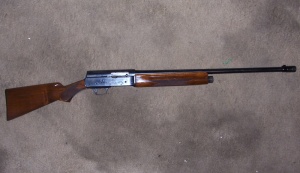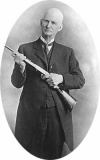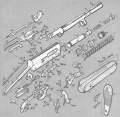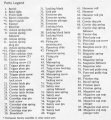Difference between revisions of "Browning Auto-5"
| Line 7: | Line 7: | ||
<!-- Specifications --> | <!-- Specifications --> | ||
|length= variable by barrel | |length= variable by barrel | ||
| − | |barrel= 20", 26", 28", 32"<ref>Fjestad, S. P., "Twenty-Third Edition {{ | + | |barrel= 20", 26", 28", 32"<ref>Fjestad, S. P., "Twenty-Third Edition {{Amazon/Blue Book}}", Blue Book Publications, Inc., 2002, p. 1141.</ref> |
|weight= variable by barrel | |weight= variable by barrel | ||
|cartridge= | |cartridge= | ||
Revision as of 13:16, 28 May 2015
| Remington Model 11 / Browning Auto-5 | |
|---|---|

| |
| Remington Model 11 Shotgun | |
|
| |
| Type | Semi-automatic shotgun |
| Land of Origin | USA |
| Specifications | |
| Length | variable by barrel |
| Barrel length | 20", 26", 28", 32"[1] |
| Weight | variable by barrel |
| Gauge | 12 gauge, 16 gauge, 20 gauge |
| Action | Semi-Automatic |
|
| |
| Feed | 3 to 5-round tube magazine |
| Service History | |
| In service | Remington 11: 1905–1947
Browning Auto-5: 1902-1999 |
| Used by | various law enforcement, military, and private citizens |
| Production History | |
| Designer | John Browning |
| Manufacturer | Browning, Savage, Franchi, FN, Remington and others |
| No. Built | 3,000,000 (Auto-5s built by Browning) 850,000 (Remington 11) |
| Variants | see article |
The Browning Auto-5 was a recoil-operated autoloading shotgun designed by John Browning. It was the first successful autoloading shotgun ever produced. It was originally produced in the United States as the Remington Model 11. The name of the shotgun designates that it is an autoloader with a capacity of five shots, four in the magazine and one in the chamber.
In 1999 Browning issued the "Final Tribute" version featuring engraved scenes of John M. Browning, the F.N. Factory and the Browning Brothers first store. Only 1,000 of these were produced in a high-grade wood. Production of the famous "A-5" ceased after this final tribute.
Contents |
History
The Browning Automatic 5 was the first mass produced semiautomatic shotgun. Designed by John Browning in 1898 and patented 1900[2], it was produced continually for almost 100 years, with production ending in 1998. It features a distinctive high rear end, earning it the nickname "Humpback". The top of the action goes straight back on a level with the barrel before cutting down sharply towards the buttstock. This distinctive feature makes it easy to identify A-5s from a distance. A-5s were produced in a variety of gauges, with 12 and 20 predominating; 16 gauge (not produced between 1976 and 1987) models were also available.
Production
John Browning presented his design (which he called his best achievement)[3] to Winchester, where he had sold most of his previous designs. When Winchester refused his terms, Browning went to Remington. Tragically, the president of Remington died of a heart attack as Browning waited to offer them the gun. This forced Browning to look overseas to produce the shotgun. It was manufactured by FN (a company that had already produced Browning-designed pistols) starting in 1902. Browning would later license the design to Remington, who produced it as their Model 11 (1905-1948). The Remington Model 11 was the first auto-loading shotgun made in the USA. Savage Arms also licensed the design from Browning and produced it as their model 720 from 1930 to 1949, and their model 745 with an alloy receiver and 2-shot magazine from 1941 to 1949. Browning's long-recoil design itself served as the operating system for subsequent Remington (11-48), Savage (755, 775) and Franchi (AL-48) models.[3]
Production of the Auto-5 in Belgium continued until the start of World War II, when Browning moved production to Remington Arms in the United States. The Auto-5 was produced by Remington along side the Model 11 until FN could resume making the gun after the war.[4] Unlike the Remington Model 11, the Remington-produced Browning shotguns had magazine cutoffs. Some 850,000 Remington Model 11 shotguns were produced before production ended in 1947. In 1952, production of Browning models returned to FN, where it continued to until the end. However, the majority of production moved to Japan in 1975. Finally, in 1998, manufacture of A-5s ceased except for a few commemorative models created at FN in 1999. By that time, it was well established as the second-best-selling auto-loading shotgun in U.S. history, after the Remington 1100.[3]
{See table below for more information)
Design
The Browning Auto-5 is a long-recoil operated semi-automatic shotgun. Shells are stored in a tubular magazine under the barrel. When a chambered shell is fired, the barrel and bolt recoil together (for a distance greater than the shell length) and recock the hammer. As the barrel returns forward to its initial position the bolt remains behind and thus the spent shell is ejected. Then the bolt returns forward and feeds another shell from the magazine into the action. While this may seem a little humdrum today, this type of long recoil action was amazing at the time, being the first of its kind and patented in 1900 by John Browning.
To load the weapon, shells are fed into the bottom of the action, where they are then pushed into the magazine. Most A-5s have removable plugs in the magazine which prevent more than 3 shells from being loaded in at one time (two in the magazine, plus one in the chamber) to comply with Canadian and U.S. Federal migratory waterfowl hunting laws, as well as some state hunting regulations. With the plug removed, the total capacity is 5 rounds. If the chamber is open (the operating handle is drawn back) the first shell loaded into the magazine tube will go directly into the chamber. The bolt then closes, and all further shells fed into the gun will go into the magazine.
The A-5 has a system of friction rings that control the rate of recoil. Setting these rings correctly is vital to good shotgun performance and to ensure a long life to the weapon, by controlling excessive recoil. The friction rings are set based on the type of load to be fired through the gun. Different settings can be found in the owner's manual (see links below).
Resources
| Gun Owners' Resource has the following relevant documents available for free download for the Browning Auto-5 and/or its variants: |
- Auto-5 Light owner's manual
- Auto-5 Magnum owner's manual
- The Auto-5 Field Service Manual
- An older Auto-5 owner's manual
- Further information can also be found at the Browning and Remington websites.
Other data
| Date | Historic Information | Serial No. Info |
|---|---|---|
| 1903-1939 | First 10,000 shipped to U.S. Marked with "BROWNING AUTOMATIC ARMS CO. OGDEN UTAH-U.S.A." Very few serial number records remain. | Beginning with Serial Number 1 to approximately 228,000. Exact production figures are not available. Year of manufacture on Pre-World War II production is strictly a guess. |
| 1940-1946 | From 1940 to 1946 production of the Auto-5 was turned over to Remington. Serial number is on the side of receiver. "ABC" for American made Version. (A=16 gauge, B-12 gauge, C=20 gauge) | 1946+229,000-237,000 |
| 1947 | 237001-249000 | |
| 1948 | 249001-270000 | |
| 1949 | 270001-285000 | |
| 1950 | 285001-315000 | |
| 1951 | 315001-346000 | |
| 1952 | F.N. took over production of the Auto-5. | 346001-387000 |
| 1953 | 387000-438000 | |
| 1954-55 | Serial Numbering System changed. H=Standard Weight. L=Light Weight. | H1-H83000 L1-L83000 |
| 1956 | Serial Number designation for the Light Weight changed to G. | H83001-H99000 G1-G23000 |
| 1957 | Serial Numbering System changed again. M=Standard Weight. G=Light Weight. | M22000-M85000 G23001-85000 |
| 1958-67 | From 1958 serial numbers were preceded by the date of manufacture. 8M=standard weight for 1958. 8G=light weight for 1958. Example: 8M1000 = A 1958 Auto-5 standard weight shotgun with serial number 1000 |
G85001-G99000 8G1-8G2000 M=standard weight G=light weight |
| 1968-76 | In 1969 Browning started using two digits for the date of manufacture which was followed by a four digit code that identified the type of Auto-5: M=standard weight G=light weight This was then followed by the serial number beginning with 1000. Example: 69G1000 = A 1969 Auto-5 Lightweight 12 ga.. shotgun with a serial number of 1000. |
M-standard weight G=light weight |
| 1976-1997 | In 1976 Browning standardized its serial number identification which it followed until 1998. 1. Auto-5 Type |
Serial Number Example: 01001RT151 This would be an Auto-5 Magnum 12 gauge, manufactured in 1976 with the serial number 01001. |
| 1999 | The Auto-5 was discontinued for 2000. To commemorate this historic event for the Auto-5, Browning released the "Final Tribute" version in 1999. 1. Serial Number beginning with 1001 at the start of each year. |
Serial Number Example: 2000FT1001 This would be a Auto-5 "Final Tribute" 12 ga., manufactured in 1999 with the serial number 1001. |
| Serial No. Blocks | Grades Offered |
|---|---|
| 12 gauge – approximately 10,000 – 794,990 16 gauge – approximately 1,500,000 – 1,557,000 |
11 A – Standard Grade 11 R – Riot Special |
References
- ↑ Fjestad, S. P., "Twenty-Third Edition Template:Amazon/Blue Book", Blue Book Publications, Inc., 2002, p. 1141.
- ↑ Harold Murtz. Gun Digest Treasury (DBI Books, 1994), p.194
- ↑ 3.0 3.1 3.2 Murtz, ibid., pp.193-4
- ↑ Firearm Model History - Remington Model 11
| This article is part of a series on the works of John Moses Browning | ||
|---|---|---|
| Semi-automatic pistols | FN M1900 · Colt M1900 · Colt M1902 · FN Model 1903 · M1903 Pocket Hammer · M1903 Pocket Hammerless · M1908 Vest Pocket · FN Model 1910 · M1911 · Colt Woodsman · Baby Browning · Hi-Power |  |
| Rifles | Winchester Model 1885 · Winchester Model 1886 · Winchester 1892 · Winchester Model 1894 · Winchester Model 1895 · Remington Model 8 · Remington Model 24 · FN Trombone | |
| Shotguns | Winchester Model 1887 · Winchester Model 1897 · Browning Auto-5/Remington Model 11 · Remington Model 17 · Savage Model 520 · Browning Superposed · Ithaca 37 | |
| Machine guns | Colt-Browning M1895 · Browning M1917 · Browning Automatic Rifle · Browning M1919 · M2 Machine Gun | |
| Cartridges | .25 ACP · .32 ACP · .38 ACP · .380 ACP · .45 ACP · .50 BMG | |




